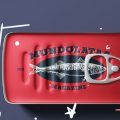Walking down the aisles of supermarkets, you’ve seen a wide variety of canned food on countless occasions, but I’m sure you’ve never stopped to think that these packaged goods were designed by science for a very different purpose. Even the simplest of these containers may have military origins, and we’re not just talking about modern times.
During the Napoleonic Wars, the French government needed a way to preserve food for the soldiers in the long term. That gave birth to canned food, even if at that time it was in sealed glass jars.
If it had not been invented, supermarket shelves would be half empty by now. Tins can last for years in the pantry and when we get hold of them they save us a lot of time in the kitchen. It is not surprising, therefore, that the origin of its popularity is to be found on the battlefields. Specifically, in those of the First and Second World War.
The diet was designed according to the position and post of the soldiers, for example: pilots were provided with a variety of foods with more calories, while submariners were given food to avoid scurvy and oxygen shortage on board. Over time, food rations were affected and food rations were reduced in size, which led to fights between cooks and soldiers.
When hot food was suspended for 24 hours (or perhaps longer), commanders authorized soldiers to eat their iron rations; these rations consisted of canned meat and packet biscuits, which resembled the US Army’s K ration (though less varied).
Eating healthily in areas of armed conflict remains one of the challenges that have dogged armies for centuries in order to provide the soldier with the number of calories and nutrients required for intense physical activity.
Over the past few decades, armies have been perfecting their food rations by concentrating the food they need into a small package they call combat rations. These packs are known among soldiers as bricks and it is easy to find videos on the internet of people doing a tasting. Almost everyone agrees that this food tastes good, and they even point out that it looks homemade.
Combat rations must be easy to preserve, stock and store. A soldier needs between 30 and 40 kilocalories per kilogram of body weight per day, depending on whether the stress-activity level is moderate or very high, the equivalent of approximately 3,000 kilocalories per day.
In the mid-20th century, scientists at Kansas State University discovered that adding heat-resistant amylases could solve the bread problem. These enzymes, which come from bacteria with a tolerance to high temperatures, remain in condition after the bread is baked, making it incredibly soft and supple for a long time.
The rations are intended to keep soldiers fed until they can reach kitchens in the field. What really matters for extending the shelf life of a food is not the absolute moisture content, but rather how many of those water molecules are floating around without being bound to anything else.
The U.S. military and NASA have funded high-impact research since the mid-twentieth century devoted to the management of moisture in food over long periods of time. Adding salt and sugar to food binds the water molecules together without making the food completely dry.
This way, you can keep a few crackers and a piece of cheese in a backpack for years without the cracker losing its crispness or the cheese losing its freshness. This technique is applied both to products for the general trade and to military rations.
Another technique is not to use heat, but pressure. When subjected to high pressure, the microorganisms burst and leave the food sterilized. This process is used today to produce preservative-free canned lunch meats, packaged guacamole, and bottled juices that offer a fresh taste (using a technique sometimes called cold pasteurization).
Processed foods and sugars
Although healthy foods such as sardines or lentils are easy to find on these menus, the bricks also contain harmful foods: condensed milk sachets, biscuits and chocolate bars at breakfast, sausages, sausages and pâtés in the food modules.
Little fruit
Another striking aspect of the combat rations is the lack of fresh fruit and vegetables due to the difficulty of preservation. In their place are fruit salads in syrup, fruit creams with sugar or energy drinks with minerals and vitamins that do not provide the same benefits. The endocrinologist reminds us that neither fruit nor vegetables are replaceable foods and that, although the processing of fruit in syrup improves the preservation of the fruit and allows us to obtain some of its benefits, it has a higher amount of free sugars.
Some of the military personnel who show the contents of these combat rations on the internet confess that eating them sometimes causes constipation.

In the Russian Army’s combat rations, due to the country’s military spending cuts, its soldiers have complained about the quality of the food. Potatoes and meat are not lacking in the rations of Russian soldiers, as well as apple products.
Estonian troops get chicken pate on their rations, Spanish soldiers get squid in oil and green beans with ham, German troops get rye bread to go with their goulash, French army personnel can dine on cassoulet, a traditional French stew. For Australian soldiers, a tube of Vegemite is a must in their rations, and Italian infantrymen get a shot of grappa, a grape-based alcoholic aperitif, to lift their spirits.













